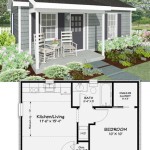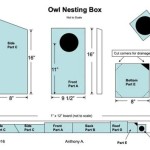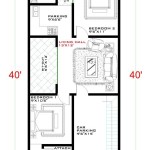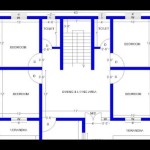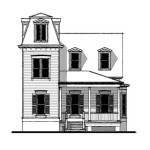Common Scales for Floor Plans
Floor plans are essential tools in architecture, interior design, and real estate. They provide a scaled representation of a building's layout, showing the arrangement of rooms, walls, doors, windows, and other structural elements. A floor plan allows stakeholders to visualize the space and ensure that it meets functional and aesthetic requirements. Understanding the common scales used in creating these plans is crucial for accurately interpreting and utilizing them.
The scale of a floor plan represents the ratio between the dimensions on the drawing and the actual dimensions of the building. For example, a scale of 1:100 means that one unit of measurement on the drawing represents 100 units of measurement in reality. The choice of scale is dependent on several factors, including the size of the building, the level of detail required, and the size of the paper or digital display on which the plan will be presented. Selecting an appropriate scale is paramount for clarity and usability. If the scale is too small, the plan may lack necessary detail. If the scale is too large, the plan may become unwieldy and impractical.
Understanding Scale Ratios
Scale ratios are expressed as a fraction or a ratio, where the first number represents the measurement on the drawing, and the second number represents the corresponding measurement in the real world. Common scales vary depending on the measurement system used: metric or imperial. In metric, scales are typically expressed as 1:50, 1:100, 1:200, and 1:500. In the imperial system, scales are often expressed in inches, such as 1/4" = 1' (one-quarter inch equals one foot) or 1/8" = 1' (one-eighth inch equals one foot). Each scale provides a different level of detail and is suitable for different applications.
The 1:50 scale is relatively large and offers a high level of detail. It is commonly used for smaller spaces, such as individual apartments, bathrooms, or kitchens. This scale allows for the inclusion of detailed information about fixtures, fittings, and finishes. Architects and interior designers often use this scale when presenting detailed design proposals to clients.
The 1:100 scale is a widely used standard for residential floor plans. It provides a good balance between detail and overall size, making it suitable for representing entire houses or individual floors of larger buildings. At this scale, major architectural elements, such as walls, doors, windows, and stairs, are clearly visible, along with basic dimensions and labels.
The 1:200 scale is suitable for larger buildings or complexes, such as office buildings, schools, or hospitals. While it offers less detail than the 1:100 scale, it allows for the representation of larger areas on a single sheet. This scale is often used for site plans or preliminary design concepts.
The 1:500 scale is typically employed for very large projects, such as urban development plans or large industrial facilities. At this scale, only the most essential features are shown, such as building outlines, roads, and major infrastructure elements. Detailed information about individual rooms or spaces is generally omitted.
In the imperial system, the 1/4" = 1' scale is roughly equivalent to the metric 1:50 scale. It is commonly used for detailed residential plans and allows for the depiction of fine details. The 1/8" = 1' scale is comparable to the 1:100 metric scale and is also widely used for residential floor plans. Other imperial scales, such as 1/16" = 1' or 3/32" = 1', may be used for larger projects, similar to the metric 1:200 or 1:500 scales.
When selecting a scale, it is important to consider the intended audience and the purpose of the floor plan. For example, a floor plan intended for construction purposes will require a higher level of detail than a floor plan used for marketing purposes. Similarly, a floor plan intended for a client presentation should be visually appealing and easy to understand.
Factors Influencing Scale Selection
Several factors influence the choice of scale for a floor plan, including the project's size and complexity, the level of detail required, and the intended use of the plan. Larger projects typically require smaller scales to fit the entire building or site on a manageable sheet size. Conversely, smaller projects may benefit from larger scales to showcase intricate details and design features.
The level of detail needed also plays a significant role. If the floor plan is intended to provide comprehensive information about the building's construction, finishes, and fixtures, a larger scale is necessary. If the plan is primarily used for conceptual design or space planning, a smaller scale may suffice.
The intended use of the floor plan also influences scale selection. For example, a floor plan used for building permits must comply with local regulations and codes, which may specify a minimum scale requirement. A floor plan used for marketing purposes should be visually appealing and easy to understand, which may require a different scale than a technical drawing.
Technological advancements have also impacted scale selection. Computer-aided design (CAD) software allows architects and designers to create floor plans at any scale and easily zoom in or out to view different levels of detail. This flexibility has made it easier to create floor plans that meet the specific needs of each project.
Despite the flexibility offered by CAD software, it is still essential to select an appropriate scale for the final printed or digital output. The chosen scale should be clearly indicated on the floor plan, along with a graphic scale bar that allows users to easily measure distances on the drawing.
Practical Applications of Different Scales
The practical applications of different floor plan scales vary depending on the specific industry and project requirements. Architects, interior designers, and real estate professionals each utilize floor plans at various scales for different purposes.
Architects use floor plans throughout the design process, from initial conceptual sketches to detailed construction documents. Early-stage design often employs smaller scales (e.g., 1:200 or 1:500) for site planning and massing studies. As the design progresses, larger scales (e.g., 1:50 or 1:100) are used to develop detailed floor plans, elevations, and sections. These detailed plans are then used to create construction documents, which specify the materials, dimensions, and construction methods for the building.
Interior designers rely heavily on floor plans to plan and visualize interior spaces. They commonly use larger scales (e.g., 1:50 or 1/4" = 1') to show the placement of furniture, fixtures, and equipment. They may also use different scales to create detailed drawings of specific areas, such as kitchens or bathrooms. Floor plans are essential for communicating design ideas to clients and ensuring that the proposed design meets their needs and preferences.
Real estate professionals use floor plans to market properties to potential buyers or tenants. Floor plans provide a clear and concise representation of the property's layout, allowing prospective buyers or tenants to visualize the space and assess its suitability. Floor plans used for marketing purposes are typically created at a scale that allows for easy comprehension, often a standard 1:100 or 1/8" = 1'. These plans may also include additional information, such as room dimensions, square footage, and the location of key features.
Beyond these specific professions, floor plans are also used in various other contexts. For example, facility managers use floor plans to track assets, plan maintenance activities, and manage space allocation. Emergency responders use floor plans to understand building layouts and plan evacuation routes. Homeowners use floor plans to plan renovations, furniture arrangements, and home improvement projects.
The accurate application and reading of floor plans depend on a clear understanding of the chosen scale. Whether working with architectural blueprints, interior design schemes, or real estate brochures, recognizing the scale ratio allows for proper interpretation of dimensions and spatial relationships. This understanding contributes to effective communication, efficient project execution, and informed decision-making across various fields.

How To Draw A Floor Plan Scale Measuring Sketching

How To Draw A Floor Plan Scale Measuring Sketching

How To Draw A Floor Plan Scale Measuring Sketching

How To Draw A Floor Plan Scale Measuring Sketching

Floor Plan Wikipedia

How To Draw A Floor Plan Live Home 3d

How To Read Floor Plans With Dimensions A Guide

How To Draw A Floor Plan Scale Measuring Sketching

How To Read Floor Plans With Dimensions A Guide

Understanding And Using Architectural Scales Archdaily
Related Posts

